oil VAUXHALL ZAFIRA 2014 Owner's Manual
[x] Cancel search | Manufacturer: VAUXHALL, Model Year: 2014, Model line: ZAFIRA, Model: VAUXHALL ZAFIRA 2014Pages: 217, PDF Size: 7.85 MB
Page 18 of 217

16In brief
Automatic transmissionP=park positionR=reverse gearN=neutral positionD=drive
The selector lever can only be movedout of P or N when the ignition is on
and the foot brake is depressed
(selector lever lock). To engage P or
R , press the release button on
selector lever.
The automatic transmission is
available in two versions 3 128.
Starting off
Check before starting off ■ Tyre pressure and condition 3 173,
3 205.
■ Engine oil level and fluid levels 3 153.
■ All windows, mirrors, exterior lighting and number plates are free
from dirt, snow and ice and are
operational.
■ Proper position of seats, seat belts and mirrors 3 46, 3 55, 3 38.
■ Brake function at low speed, particularly if the brakes are wet.Starting engine with ignition
switch
■ Turn key to position 1
■ Move the steering wheel slightly to release the steering wheel lock
■ Operate clutch and brake, automatic transmission in P or N
■ Do not operate the accelerator pedal
■ Diesel engines, turn the key to position 2 for preheating and wait
until control indicator ! goes out
■ Turn key to 3 and release key when
engine is running.
Page 92 of 217

90Instruments and controlsPreheating and diesel
particle filter ! illuminates or flashes yellow.
Illuminates Preheating activated. Only activates
when outside temperature is low.
Flashes Control indicator ! flashes if the
diesel particle filter requires cleaning
and previous driving conditions did
not permit automatic cleaning.
Continue driving and if possible do
not allow engine speed to drop below
2000 rpm.
The control indicator ! goes off as
soon as the self-cleaning operation is complete.
Diesel particle filter 3 127.
Deflation detection system
and tyre pressure
monitoring system
w illuminates or flashes red or yellow.Control indicator illuminates red
Tyre pressure loss. Stop immediately
and check tyre pressure. A maximum speed of 50 mph is permitted for run-
flat tyres 3 172.
Control indicator illuminates
yellow
Fault in system or tyre without
pressure sensor mounted (e.g. spare
wheel). Consult a workshop.
Flashes
Flashes three times to indicate system initialisation.
Deflation detection system 3 175,
tyre pressure monitoring system
3 174.
Interactive driving system, continuous damping
control, sport mode IDS+ illuminates yellow.
Illuminates for approximately
10 seconds after the driver's door is
opened. Illumination whilst drivingindicates a fault in the system. The
system switches to the harder chassis setting for reasons of safety. Have the
cause of the fault remedied by a workshop.
IDS Plus
3 140, Continuous damping
control 3 141, Sport mode 3 140.
Engine oil pressure I illuminates red.
Illuminates when the ignition is
switched on and goes out shortly after
the engine starts.
Illuminates when the engine isrunningCaution
Engine lubrication may be
interrupted. This may result in
damage to the engine and/or
locking of the drive wheels.
1. Depress clutch.
2. Select neutral gear, set selector lever to N.
Page 93 of 217

Instruments and controls91
3. Move out of the flow of traffic asquickly as possible without
impeding other vehicles.
4. Switch off ignition.9 Warning
When the engine is off,
considerably more force is needed
to brake and steer.
Do not remove key until vehicle is stationary, otherwise the steering
wheel lock could engage
unexpectedly.
Check oil level before seeking the
assistance of a workshop 3 153.
Low engine oil level
S illuminates yellow.
Engine oil level is checked
automatically.
Illuminates when the engine is
running
Low engine oil level. Check engine oil
level and top up as necessary
3 153.
Low fuel Y illuminates or flashes yellow.
Illuminates Level in fuel tank too low.
Flashes
Fuel used up. Refuel immediately.
Never run the tank dry.
Catalytic converter 3 128.
Bleeding the diesel fuel system
3 157.
Open&Start system
0 illuminates or flashes yellow.
Flashes The electronic key is no more within
the reception range of the vehicle interior. The engine cannot bestarted. Hold the Start/Stop button
depressed a bit longer to switch off
the ignition.
or
Failure of the electronic key.
Operation is yet only possible via
emergency operation.
Illuminates
Fault in system. Try to operate with
the spare key, the remote control or
through emergency operation. Hold
the Start/Stop button depressed a bit
longer to switch off the ignition. Seek the assistance of a workshop.
or
The steering wheel lock is still
engaged. Move the steering wheel
slightly and press the Start/Stop
button.
Open&Start system 3 28.
Apply footbrake
j illuminates yellow.
Page 126 of 217

124Driving and operatingDriving and operatingDriving hints............................... 124
Starting and operating ...............124
Engine exhaust .......................... 127
Automatic transmission .............. 128
Manual transmission ..................133
Manual transmission automa‐
ted .............................................. 134
Brakes ........................................ 138
Ride control systems .................139
Cruise control ............................. 141
Object detection systems ........... 142
Fuel ............................................ 144
Trailer hitch ................................ 146Driving hints
Control of the vehicleNever coast with engine not
running
Many systems will not function in this
situation (e.g. brake servo unit, power
steering). Driving in this manner is a
danger to yourself and others.
Pedals To ensure the pedal travel is
uninhibited, there must be no mats in
the area of the pedals.Starting and operating
New vehicle running-in Do not brake unnecessarily hard for
the first few journeys.
During the first drive, smoke may
occur because of wax and oil
evaporating off the exhaust system.
Park the vehicle in the open for a
while after the first drive and avoid
inhaling the fumes.
During the running-in period fuel and
engine oil consumption may be
higher and the cleaning process of the diesel particle filter may take
place more often. Diesel particle filter 3 127.
Page 128 of 217

126Driving and operating
To repeat the starting procedure or to
switch off the engine, press the button again.
Starting the vehicle at low
temperatures
The start of the engine without
additional heaters is possible down to -25 °С for diesel engines and -30 °C
for petrol engines. Required is an engine oil with the correct viscosity,
the correct fuel, performed services
and a sufficiently charged battery.
With temperatures below -30 °C the
automatic transmission and the
manual transmission automated
need a warming phase of approx. 5
minutes. The selector lever must be
in position P respectively N.
Overrun cut-off The fuel supply is automatically cut off
during overrun, i.e. when the vehicle
is driven with a gear engaged but
accelerator is released.Parking
■ Do not park the vehicle on an easily
ignitable surface. The high
temperature of the exhaust system
could ignite the surface.
■ Always apply parking brake without
pressing release button. Apply as
firmly as possible on downhill or
uphill slopes. Depress the foot
brake at same time to reduce
operating force.
■ Switch off the engine and ignition. Turn the steering wheel until the
steering wheel lock engages.
■ If the vehicle is on a level surface or
uphill slope, engage first gear or set
the selector lever to P before
switching off the ignition. On an
uphill slope, turn the front wheels
away from the kerb.
If the vehicle is on a downhill slope, engage reverse gear or set theselector lever to P before switchingoff the ignition. Turn the front
wheels towards the kerb.
■ Lock the vehicle and activate the anti-theft locking system and the
anti-theft alarm system.
Page 133 of 217
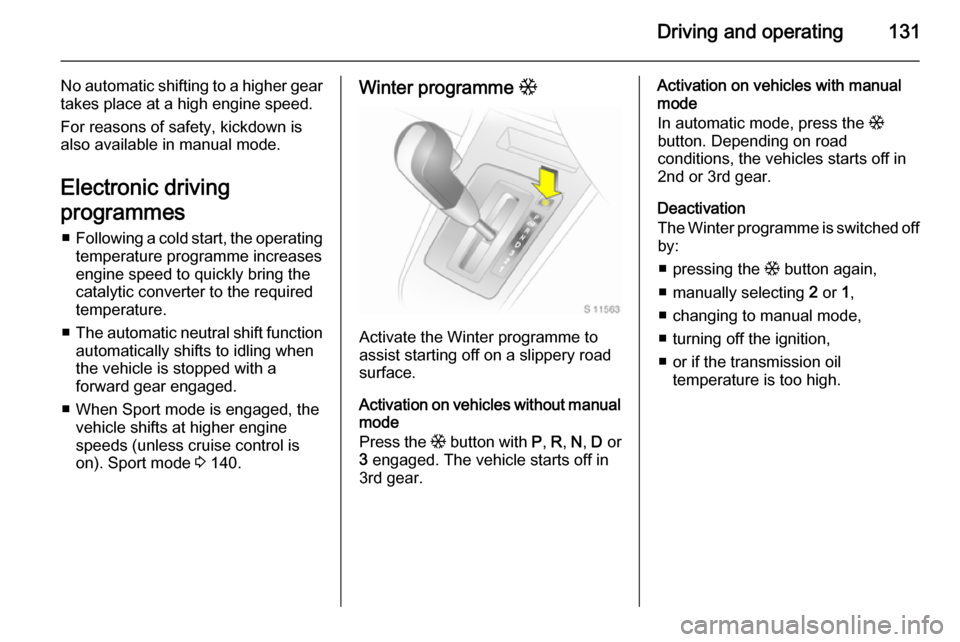
Driving and operating131
No automatic shifting to a higher geartakes place at a high engine speed.
For reasons of safety, kickdown is
also available in manual mode.
Electronic driving
programmes ■ Following a cold start, the operating
temperature programme increases
engine speed to quickly bring the
catalytic converter to the required
temperature.
■ The automatic neutral shift function
automatically shifts to idling when
the vehicle is stopped with a
forward gear engaged.
■ When Sport mode is engaged, the vehicle shifts at higher engine
speeds (unless cruise control is
on). Sport mode 3 140.Winter programme T
Activate the Winter programme to
assist starting off on a slippery road surface.
Activation on vehicles without manual
mode
Press the T button with P, R , N , D or
3 engaged. The vehicle starts off in
3rd gear.
Activation on vehicles with manual mode
In automatic mode, press the T
button. Depending on road
conditions, the vehicles starts off in 2nd or 3rd gear.
Deactivation
The Winter programme is switched off by:
■ pressing the T button again,
■ manually selecting 2 or 1,
■ changing to manual mode,
■ turning off the ignition,
■ or if the transmission oil temperature is too high.
Page 146 of 217
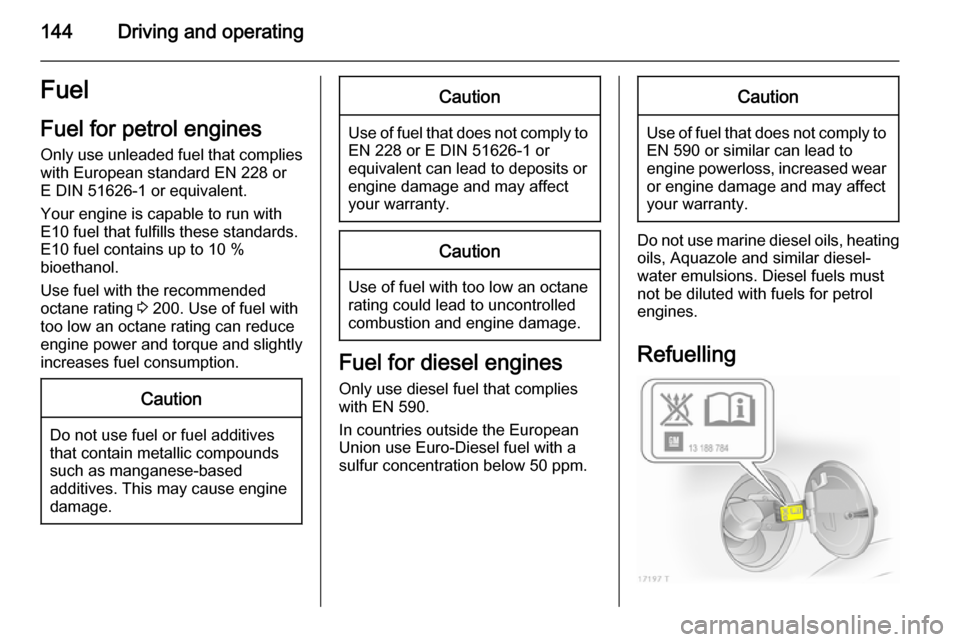
144Driving and operatingFuel
Fuel for petrol engines Only use unleaded fuel that complies
with European standard EN 228 or E DIN 51626-1 or equivalent.
Your engine is capable to run with
E10 fuel that fulfills these standards.
E10 fuel contains up to 10 %
bioethanol.
Use fuel with the recommended
octane rating 3 200. Use of fuel with
too low an octane rating can reduce
engine power and torque and slightly increases fuel consumption.Caution
Do not use fuel or fuel additives
that contain metallic compounds
such as manganese-based
additives. This may cause engine
damage.
Caution
Use of fuel that does not comply to EN 228 or E DIN 51626-1 or
equivalent can lead to deposits or
engine damage and may affect
your warranty.
Caution
Use of fuel with too low an octane
rating could lead to uncontrolled combustion and engine damage.
Fuel for diesel engines
Only use diesel fuel that complies
with EN 590.
In countries outside the European
Union use Euro-Diesel fuel with a
sulfur concentration below 50 ppm.
Caution
Use of fuel that does not comply to EN 590 or similar can lead to
engine powerloss, increased wear
or engine damage and may affect
your warranty.
Do not use marine diesel oils, heating
oils, Aquazole and similar diesel-
water emulsions. Diesel fuels must
not be diluted with fuels for petrol
engines.
Refuelling
Page 153 of 217
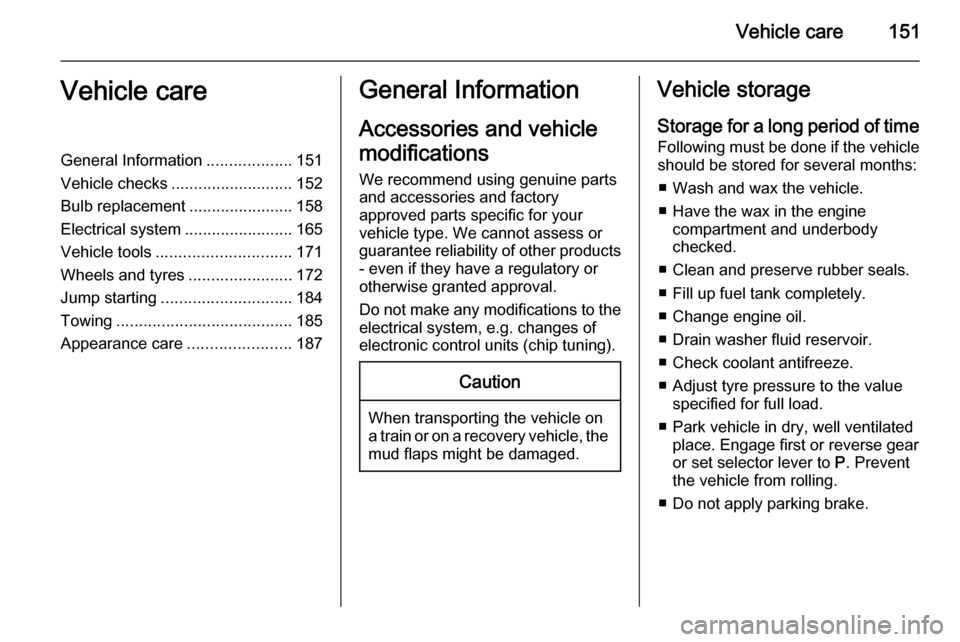
Vehicle care151Vehicle careGeneral Information...................151
Vehicle checks ........................... 152
Bulb replacement .......................158
Electrical system ........................165
Vehicle tools .............................. 171
Wheels and tyres .......................172
Jump starting ............................. 184
Towing ....................................... 185
Appearance care .......................187General Information
Accessories and vehicle
modifications
We recommend using genuine parts and accessories and factory
approved parts specific for your
vehicle type. We cannot assess or guarantee reliability of other products
- even if they have a regulatory or
otherwise granted approval.
Do not make any modifications to the electrical system, e.g. changes of
electronic control units (chip tuning).Caution
When transporting the vehicle on
a train or on a recovery vehicle, the
mud flaps might be damaged.
Vehicle storage
Storage for a long period of time
Following must be done if the vehicle
should be stored for several months:
■ Wash and wax the vehicle.
■ Have the wax in the engine compartment and underbody
checked.
■ Clean and preserve rubber seals.
■ Fill up fuel tank completely.
■ Change engine oil.
■ Drain washer fluid reservoir.
■ Check coolant antifreeze.
■ Adjust tyre pressure to the value specified for full load.
■ Park vehicle in dry, well ventilated place. Engage first or reverse gear
or set selector lever to P. Prevent
the vehicle from rolling.
■ Do not apply parking brake.
Page 154 of 217
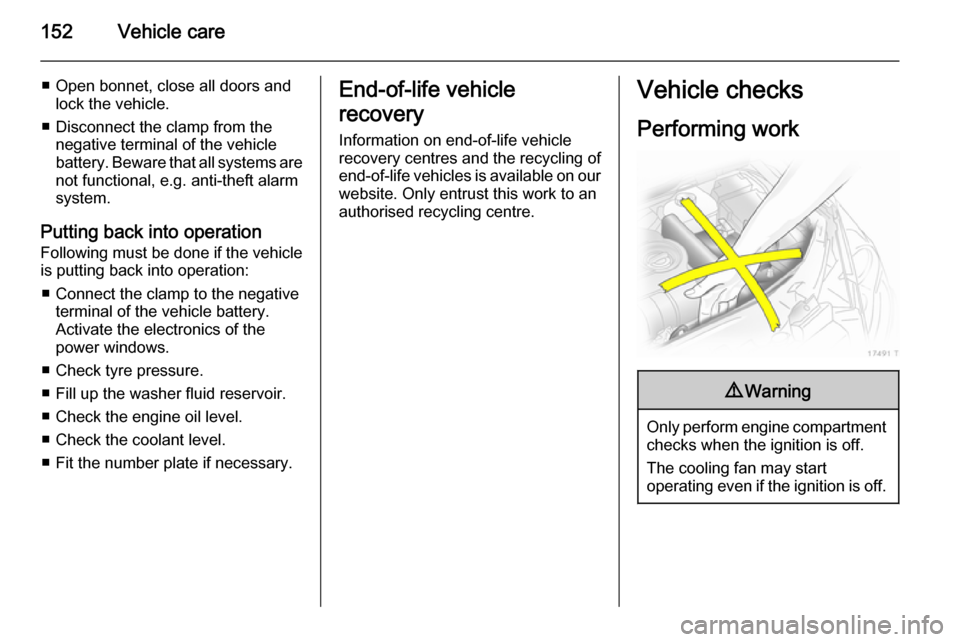
152Vehicle care
■ Open bonnet, close all doors andlock the vehicle.
■ Disconnect the clamp from the negative terminal of the vehicle
battery. Beware that all systems are not functional, e.g. anti-theft alarm
system.
Putting back into operation Following must be done if the vehicle
is putting back into operation:
■ Connect the clamp to the negative terminal of the vehicle battery.
Activate the electronics of the
power windows.
■ Check tyre pressure.
■ Fill up the washer fluid reservoir.
■ Check the engine oil level.
■ Check the coolant level.
■ Fit the number plate if necessary.End-of-life vehicle
recovery
Information on end-of-life vehicle
recovery centres and the recycling of
end-of-life vehicles is available on our website. Only entrust this work to an
authorised recycling centre.Vehicle checks
Performing work9 Warning
Only perform engine compartment
checks when the ignition is off.
The cooling fan may start
operating even if the ignition is off.
Page 155 of 217
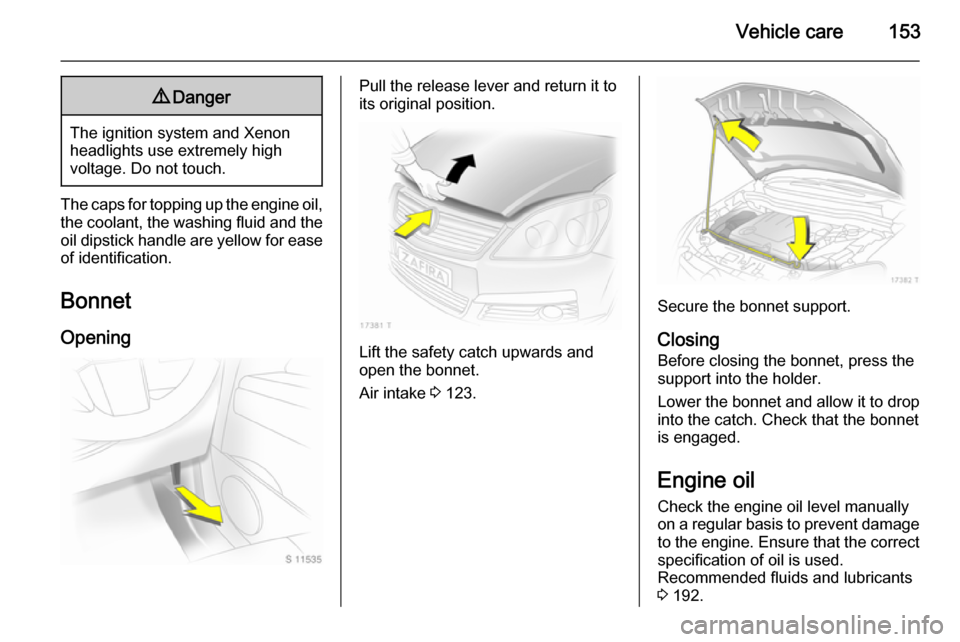
Vehicle care1539Danger
The ignition system and Xenon
headlights use extremely high
voltage. Do not touch.
The caps for topping up the engine oil, the coolant, the washing fluid and theoil dipstick handle are yellow for ease
of identification.
Bonnet
Opening
Pull the release lever and return it to
its original position.
Lift the safety catch upwards and
open the bonnet.
Air intake 3 123.
Secure the bonnet support.
Closing Before closing the bonnet, press the
support into the holder.
Lower the bonnet and allow it to drop into the catch. Check that the bonnet
is engaged.
Engine oil Check the engine oil level manuallyon a regular basis to prevent damage
to the engine. Ensure that the correct specification of oil is used.
Recommended fluids and lubricants
3 192.